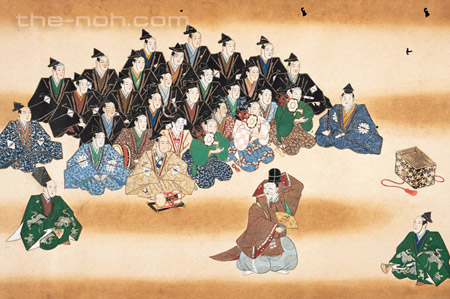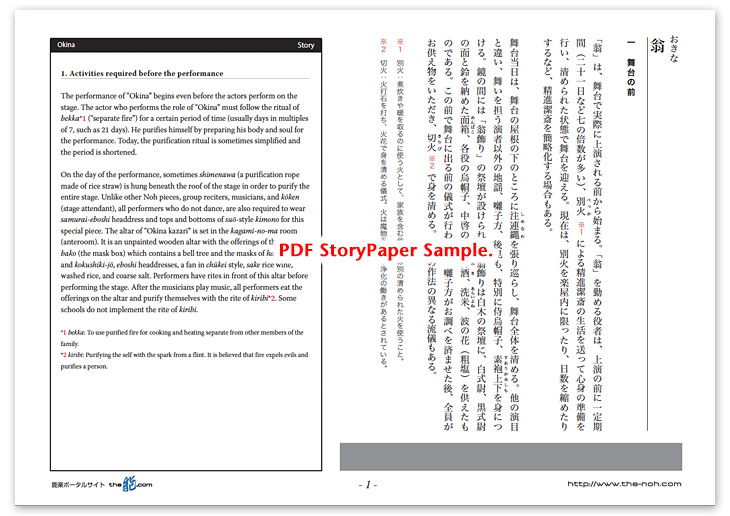
 Okina
Okina

![]()
It is said that “Okina is a Noh play yet it isn’t.” Unlike many other pieces, this piece is in a class of its own; it does not belong to any category and has no storyline. This is rather a sacred rite, in which the actors perform divine figures who dance for peace, prosperity, and safety across the land.
“Okina” is a very ancient piece, and its inscrutable origin lays in the mists of the history. In his “Fūshi Kaden”, Zeami mentioned that Hada no Ujiyasu, a descendent of Hada no Kōkatsu, the patriarch of Sarugaku, performed 66 Sarugaku pieces which were handed down from Kōkatsu in order to pray for the happiness during the reign of Emperor Murakami (10th century). Later, he selected three pieces out of the 66 and together called “Shiki-sanban” (an alias of “Okina”). The Shiki-sanban that Zeami mentioned were three pieces of dance (Chichi-no-jō, Okina (or Okina-men), and Sanba-sarugaku) that three old deities perform respectively to pray for happiness. These three pieces are performed together as a set. In later years, Chichi-no-jō was no longer performed, and today we perform in the order of Senzai, Okina, and Sanba-sō.
The performance of “Okina” starts even before it begins on stage. The performer of “Okina” must purify himself for a certain period of time before he performs the play. By doing so, he prepares his body and mind for the performance.
On the day of the performance, sometimes shimenawa (a sacred rope made of rice straws) is placed above across the stage to purify the place. The altar is established in the kagami-no-ma (“mirror room” or anteroom). Some of the offerings include a men-bako (the mask box), which contains the masks used for the performance, and sake (Japanese rice wine) which is offered at the altar and used for a ritual.
At the opening of the performance, shite (Okina), Senzai, Sanba-sō, music players and other performers enter the stage in this order via the gangway bridge, led by the men-bako bearer. In the Konparu, Kongō, and Kita schools, the men-bako bearer performs Senzai, so one less person appears on the stage compared to the other schools.
On the stage, the shite takes a seat after bowing deeply. Following the music of three small hand drums and a Japanese flute, the shite begins to sing with group reciters in relays. Then, Senzai dances. Senzai plays the role of an usher in this dance. While Senzai is dancing, the shite dons the mask of Okina, which transforms him to a deity.
Okina steps forward and dances, and after the dance, he takes off his mask. Bowing deeply again on the stage, the Okina and Senzai leave the stage via the gangway bridge. This scene is called okina-gaeri (Departure of Okina). (Senzai does not leave the stage in the performance by the Konparu, Kongō, and Kita schools.)
After Sanba-sō appears and dances “momi-no-dan” without mask, he dons the mask of kokushiki-jō and has a dialogue with the men-bako bearer. He is then given a bell tree to perform the dance of “suzu-no-dan”.
![]()
Noh plays are always performed with serene dignity and some tension, but unlike other pieces, “Okina” has a unique atmosphere, the atmosphere of sacred rites. Once the performance starts, you are prohibited to enter or exit the auditorium. As participants and witnesses of the rite, the audience also enters the mystical realm. It is difficult to explain in detail the atmosphere of Okina. Please go see the performance of Okina and experience the sacredness.
STORY PAPER : Okina
Story Paper presents noh chant stories in modern speech, with story outlines, highlights and more using Adobe PDF format, which can print out and zoom in. Print out the pages and take them with you when you see the actual noh performance.

The copyright of Story Paper is held by the Noh.com. Story Paper is for individual use only. It is prohibited by the copyright law to distribute or publish printed-out Story Paper pages without prior consent. For more information, check the credit and disclaimer pages.



 [Okina : Story Paper PDF : 460KB
[Okina : Story Paper PDF : 460KB